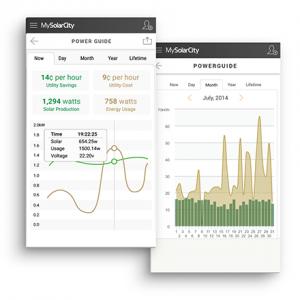Most people who switch to the use of solar energy for their homes do so because they know how much money they can save on a long-term basis. Plus, consumers will also sometimes feel they have more of a sense of control as to how much, or how little, energy consumption they actually use. However, SolarCity’s Vice for Communications Jonathan Bass observed that some people become obsessed in self-monitoring their solar use.
As a result of this growing market demand, SolarCity has since released their new MySolarCity app which informs the user of real-time usage of home energy. The MySolarCity app has been designed by SolarCity to address the needs of energy use-conscious customers and offers basic assessments for energy consumption and provides a social network through which users can exchange tips and other useful information they have gathered from their solar use.
MySolarCity app connecting like-minded consumers
Although SolarCity’s customers have had real-time solar panel monitoring for quite some time now, this new app will streamline and simplify this process. With the MySolarCity app it is now as easy as checking your phone and adjusting your residential energy use as required. Arguably, this particular industry has advocates who are divided on this issue. Some think that people do not need to see their energy usage in real-time to make certain consumption adjustments.
While some consumers become intrigued with the accuracy of the MySolarCity app, turning appliances, gadgets, devices, and other equipment on and off and seeing how this can affect overall energy consumption in their households. This is the exact market MySolarCity was created for, albeit it has only a few of the de rigueur bells and whistles of other utility apps and very basic at that; such as alerts whenever usage has become abnormally high.
New technology spreading the word on the many benefits of solar
One extremely useful feature of this app is the EnergyExplorer, a simplified piece of technology which offers the user forecasts on one’s household energy consumption. A more advanced, similar version of technology can be seen in other products such as Opower or Bidgely. Previous to the MySolarCity and EnergyExplorer, SolarCity was doing a small volume of efficiency upgrades and audits.
SolarCity has since shifted to just recommending audits without actually performing the task itself. Beyond energy features, MySolarCity app enables customers to see the other solar power installations are within their area and share photos and stories of their own solar experience. While this feature called Amplt! has been live only for several days, users have already uploaded photos.
According to Bass, SolarCity intends to go on the crowdsourcing bandwagon and use social media to inform existing and potential customers of marketing efforts in the future, a strategy which may actually reduce MySolarCity’s cost. However the company is not alone in providing solar energy efficiency or even vice-versa. There is also Vivint, which is considered the number two solar installer after SolarCity.
SolarCity’s biggest competitor Vivant has released a similar product
Vivint’s home security business now offers the so-called “smart home services” that includes appliance control and smart thermoexististats and on the side of providing energy efficiency, startups Bidgely and Energy Aware are marketing their platforms for home energy as supportive of solar power. MySolarCity app, however, is by far and large, the leader of the pack as of the moment.
The Solar Ambassadors program has over 30,000 members since it was launched in May 2014. Educational resources and a “leader board” are some of the program’s features. Anyone in the United States is encouraged to “spread the word” of solar power and the numerous benefits of using the renewable energy which earns rewards for the ambassador through referrals of new customers.



